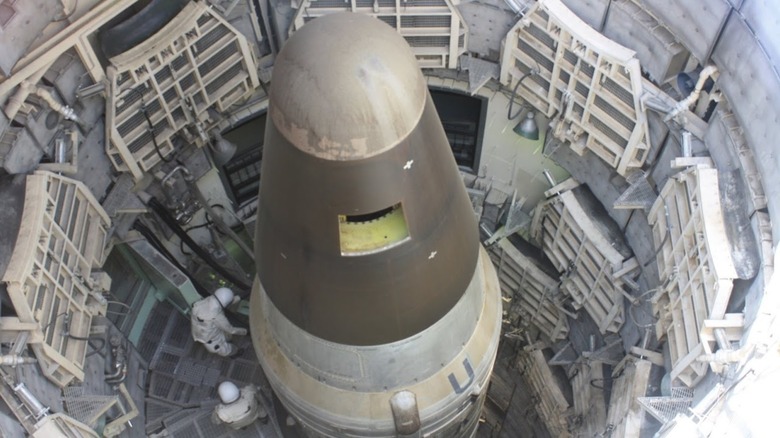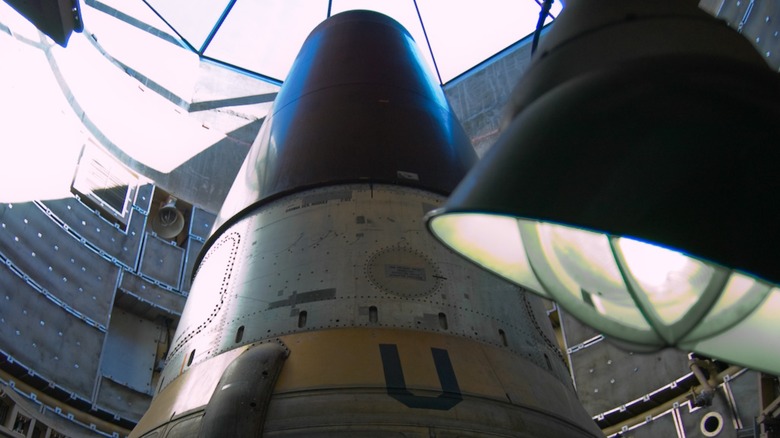How One Accident Blew Up A Nuclear Missile Silo In Arkansas
Nuclear missile silos are some of the most important strategic assets in the United States' Nuclear Triad. Because of this, silos are heavily defensible with massive overhead doors hardened against taking a direct nuclear strike (theoretically). The U.S. has invested millions into these locations since they first entered service in 1959. The nation spent around $170 million in the 1960s ($1.85 billion in 2025) on each silo, so they were considerably expensive areas to maintain, and ensuring their survivability during peacetime and in a potential nuclear conflict was paramount.
Because of this, it's unfathomable that in 1980, a missile silo in Arkansan blew up because of an accident, and no, the missile didn't go off or anything of the sort. Not only did the accident result in the destruction of a multi-million-dollar strategic nuclear asset, but it was so bad that the United States shut down the Titan II missile program. The accident was catastrophic, but it wasn't reported in detail to the world until the following year, when Walter Pincus, a reporter for the Washington Post, provided a detailed report of the incident to the Arkansas Times.
The accident was incredibly destructive, resulting in an explosion that killed an Airman and blasted a nine megaton hydrogen bomb 100 feet into the air. It was such a monumental incident that it shifted American policy regarding its intercontinental ballistic missile (ICBM) programs, and the site has since been listed in the National Register of Historic Places. Here's what happened on that fateful day on September 19, 1980, just outside of Damascus, Arkansas.
The Damascus Incident
The so-called Damascus Incident remains one of the worst military accidents involving nuclear weapons, and the bomb didn't even detonate. Still, nuclear armed ICBMs are inherently dangerous even when they're not used, which was the case in this particular incident. The accident occurred at the Titan II Launch Complex 374-7, which was the site of a previous accident that occurred on January 27, 1978. In that incident, an oxidizer leak resulted in a cloud of toxic fumes that drifted over an interstate highway, resulting in an evacuation and injuries to four people.
The accident on September 18, 1980, was considerably more devastating. It happened while an Airman was working on the silo's Titan II missile when he dropped a wrench socket. It dropped around 80 feet before puncturing the skin of the missile's first-stage fuel tank. It immediately began to leak, so a hazard team was dispatched to repair the damage. An hour later, evacuations began as the hazard team worked to get inside, only to be stopped by the blast doors. The next morning, airborne fuel concentrations were listed at the maximum, and just as a repair crew awaited instructions, the missile exploded.
The explosion caused the 740-ton launch closure door to fly 200 feet into the sky. The warhead, which was a nine-megaton W-53 thermonuclear "hydrogen" bomb, flew up and landed around 100 feet from the gate. Fortunately, the warhead didn't detonate, as it was designed to do so only if certain conditions were met and its safety features functioned as designed. One airman on the site was injured, while another died from his injuries. In total, 21 people were injured by the explosion or its aftermath.
The aftermath
The explosion didn't just destroy the missile, it took out the entire silo, rendering it inoperable. President Jimmy Carter addressed the incident to Arkansas citizens, informing them that there was no danger of radiation. The warhead was later retrieved, and the damaged silo was filled with debris, gravel, and soil. This was done because it would have cost an estimated $225,322,670 ($879 million in 2025) to repair the facility, with additional cleanup costs amounting to $20 million ($78 million in 2025).
The accident triggered a Congressional inquiry, which recommended changes to how the Air Force should communicate with local authorities in the case of future accidents. The Titan II missile program was found to have problems, and the Air Force admitted to Congress that between 1975 and 1979, more than 130 leaks occurred, requiring the fuel and oxidizer to be downloaded from multiple missiles. These resulted in 29 major health problems and 61 minor ones. The Titan II program was slated for retirement in the early 1970s, but the service wanted to keep them as they made up the majority of the Air Force's silo-based ICBMs.
Still, the accident was a wake-up call to the service, which begrudgingly had to admit that the Titan II's time was finished. By 1982, the decommissioning of the Titan II missiles in U.S. silos began, and the program was finally completed in 1987. A single Titan II was spared the scrapyard, though it was decommissioned, and because it was used for training, it was never fueled or armed. It now rests in its open silo for the public at the Titan Missile Museum in Sahuarita, Arizona.


